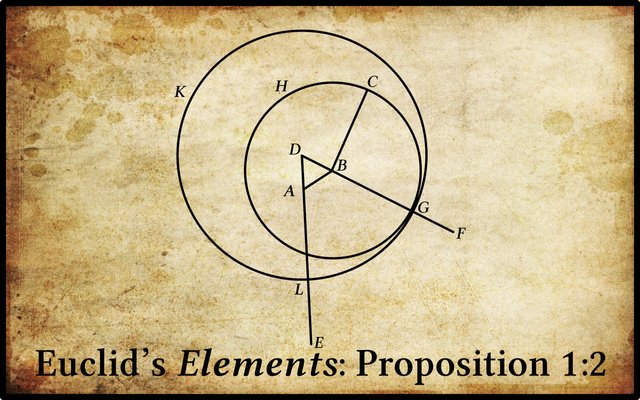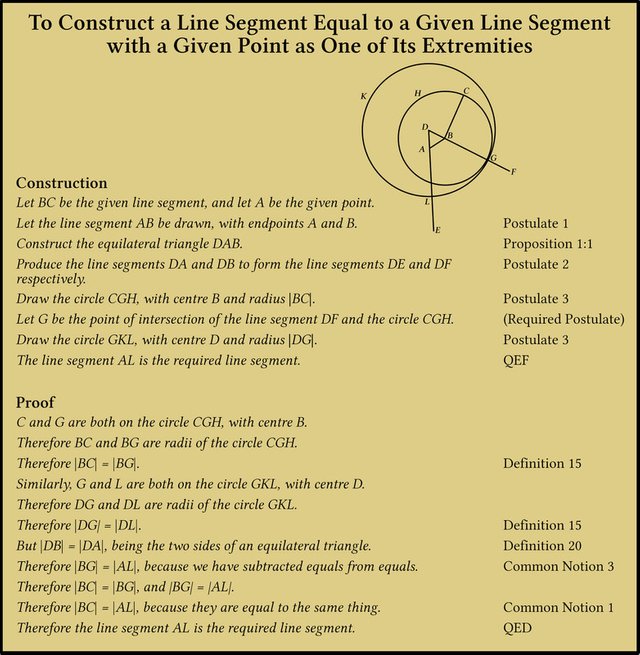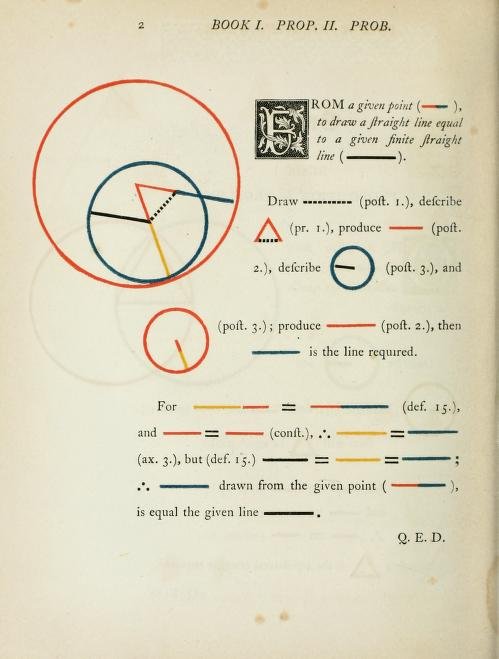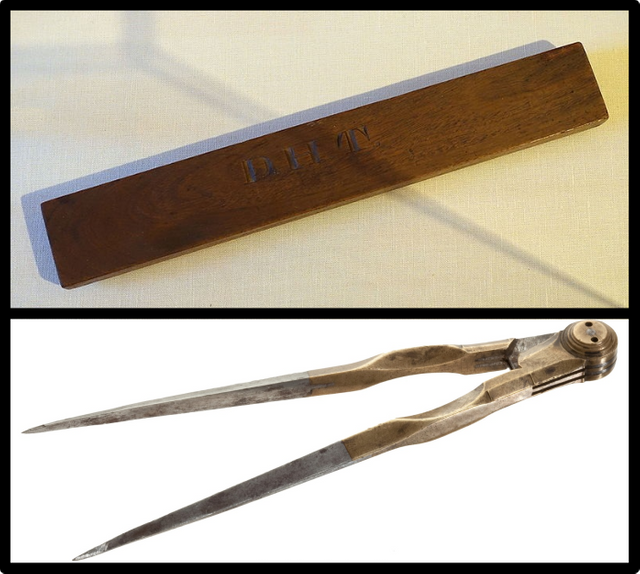Euclid’s Proposition 1:2

Book 1 of Euclid’s Elements opens with three constructions. The second of these demonstrates how to construct a line segment which is equal in length to a given line segment and which has a given point as one of its endpoints (Fitzpatrick 8):
| Greek | English |
|---|---|
| Πρὸς τῷ δοθέντι σημείῳ τῇ δοθείσῃ εὐθείᾳ ἴσην εὐθεῖαν θέσθαι. | To place a straight-line equal to a given straight-line at a given point (as an extremity). |
Euclid only uses the result of this proposition once in the remainder of the Elements: namely, in the very next proposition, 1:3.
This proposition and its demonstration may be expressed in modern language as follows:

Different Cases
One of Euclid’s translators, Richard Fitzpatrick, adds the following footnote to this construction:
This proposition admits of a number of different cases, depending on the relative positions of the point A and the line BC. In such situations, Euclid invariably only considers one particular case―usually, the most difficult―and leaves the remaining cases as exercises for the reader. ―Fitzpatrick 9
Thomas Heath adds a little more historical detail to this comment:
... Euclid’s method is to give one case only, for choice the most difficult, leaving the reader to supply the rest for himself. Where there was a real distinction between cases, sufficient to necessitate a substantial difference in the proof, the practice was to give separate enunciations and proofs altogether as we may see, e.g., from the Conics and the De sectione rationis of Apollonius. ―Heath 246
The Neoplatonist philosopher Proclus, who wrote his Commentary on the First Book of Euclid’s Elements in the 5th century, devotes most of his commentary on this proposition to a discussion of the multitude of cases that can arise―a practice the Greek commentators revelled in (Heath 245). For Proclus, Euclid’s propositions comprise problems (constructions) and theorems (propositions that prove some geometric truth):
Some problems have no cases, while others have many; and the same is true of theorems. A proposition is said to have cases when it has the same force in a variety of diagrams, that is, can be demonstrated in the same way despite changes in position, whereas one that succeeds only with a single position and a single construction is without cases. For the presence of cases, whether in a theorem or a problem, generally shows itself in the constructions. Now our second problem has many cases. In it the point is given in position, and given only in this way; but the line is given both in species (for it is not simply a line, but this kind of line) and in position. We want to place a straight line equal to this straight line with its extremity at the given point, wherever the point may lie. It is evident in any case that the point is in the assumed plane of the straight line and not in a plane above it; for we must assume one plane for all the problems and theorems of plane geometry. ―Morrow 174–175

The different cases arise as the position of the given point relative to the given line segment changes:
It is clear that cases of this problem arise from differences in the position of the point. The given point lies either outside the given straight line or on it; and if it lies on it, it will be at one of the two extremities or between them; and if it lies off the line, it will either be at one side, so that the line joining it with the extremity of the straight line will make an angle with it, or lie in the direction of the given line, so that the line if prolonged will fall upon the point. ―Morrow 175
As the American philosopher and mathematician Ian Mueller has noted, Euclid is rarely careful to distinguish between lines, which are infinitely long, and line segments, which are of finite length:
Euclid’s use of the words ‛finite’ and ‛infinite’ is quite careless. Usually he omits both and assumes that he is dealing with finite lines. Nothing he proves requires the use of infinite lines. ―Morrow 175 fn 42
Euclid refers to both as straight lines (εὐθεῖα γραμμή), or simply as straights (εὐθεῖα). In fact, the term γραμμή only occurs in the Elements four times. Three of those are in Definitions 2–4 of Book 1. The only other time he refers to a line as γραμμή is Proposition 3 of Book 11.

Euclid’s Collapsing Compass
This proposition demonstrates an important principle of Euclidean geometry. We are not allowed to use a compass to transfer distances directly from one part of the plane to another. This might seem unduly restrictive in a constructive geometry―and as we saw in an earlier article, Euclidean geometry has often been characterized as constructive:
Euclidean geometry, as presented by Euclid, consists of straightedge-and-compass constructions and rigorous reasoning about the results of those constructions ... The phrase “constructive geometry” suggests, on the one hand, that “constructive” refers to geometrical constructions with straightedge and compass. On the other hand, the word “constructive” may suggest the use of intuitionistic logic. (Beeson 19 ... 20)
The compass which is used to construct Euclidean circles is sometimes described as a collapsible compass: it collapses when lifted from the page, so that it may not be used to transfer distances. This is why Euclid’s requires Proposition 1:2. This construction proves that even a collapsing compass can be used to transfer distances indirectly by following a multi-step procedure (Straightedge-And-Compass Construction). It is for this reason that this proposition is sometimes known as the Compass Equivalence Theorem.
We have also had occasion to refer to another peculiarity of the Elements:
All the diagrams in Euclid can be constructed using only a straightedge and a collapsing compass.
But nowhere in the thirteen books of the Elements does Euclid actually mention either the straightedge or the compass.
The only basic constructions that Euclid allows are those described in Postulates 1, 2, and 3. Euclid then builds new constructions (such as the one in this proposition) out of previously described constructions. So at this point, the only constructions available are those of the three postulates and the construction in proposition I.1, and Euclid uses all four here. ―Joyce
Postulate 1. To draw a straight line from any point to any point.
Postulate 2. To produce a finite straight line continuously in a straight line.
Postulate 3. To describe a circle with any centre and radius.
Proposition 1:1 To construct an equilateral triangle.
The simplest explanation of this peculiar feature is Euclid’s Platonic approach to geometry. Straightedges and compasses are material tools that one may use to make marks on a page. Those marks may represent points, lines, circles and other geometric objects, but they are not those objects. Geometric objects, like the Platonic Forms or Ideas, are immaterial and can be apprehended only by the mind. Euclid’s points, lines and circles exist eternally on some immaterial, heavenly plane.
And that’s a good place to stop.
References
- Ernst Ferdinand August, Euclidis Elementa, Part 1, Theodor Trautwein, Berlin (1826)
- Michael Beeson, Constructive Geometry, Proceedings of the 10th Asian Logic Conference, Pages 19-84, World Scientific Publishing Co Pte Ltd, Singapore (2010)
- Henry Billingsley (translator), The Elements of Geometrie of the Most Auncient Philosopher Evclide of Megara, John Day, London (1582)
- Oliver Byrne, The First Six Books of The Elements of Euclid in Which Coloured Diagrams and Symbols Are Used Instead of Letters for the Greater Ease of Learners, William Pickering, London (1847)
- Richard Fitzpatrick (translator), Euclid’s Elements of Geometry, University of Texas at Austin, Austin, TX (2008)
- Thomas Little Heath (translator & editor), The Thirteen Books of Euclid’s Elements, Second Edition, Dover Publications, New York (1956)
- Johan Ludvig Heiberg, Heinrich Menge, Euclidis Elementa edidit et Latine interpretatus est I. L. Heiberg, Volumes 1-5, B G Teubner Verlag, Leipzig (1883-1888)
- Henry George Liddell, Robert Scott, A Greek-English Lexicon, Eighth Edition, American Book Company, New York (1901)
- Glenn Raymond Morrow (translator), Proclus: A Commentary on the First Book of Euclid’s Elements, Princeton University Press, Princeton, NJ (1970)
- François Peyrard, Les Œuvres d’Euclide, en Grec, en Latin et en Français, Volumes 1-3, Charles-Frobert Patris, Paris (1814, 1816, 1818)
- Thomas Taylor, The Philosophical and Mathematical Commentaries of Proclus on the First Book of Euclid’s Elements, Volume 1, Volume 2, London (1792)
Image Credits
- Henry David Thoreau’s Straightedge, Concord Museum, Concord, Massachusetts, Daderot (photographer), Public Domain
- George Washington’s Compass, © 2021 Heritage Auctions, Fair Use
Online Resources
